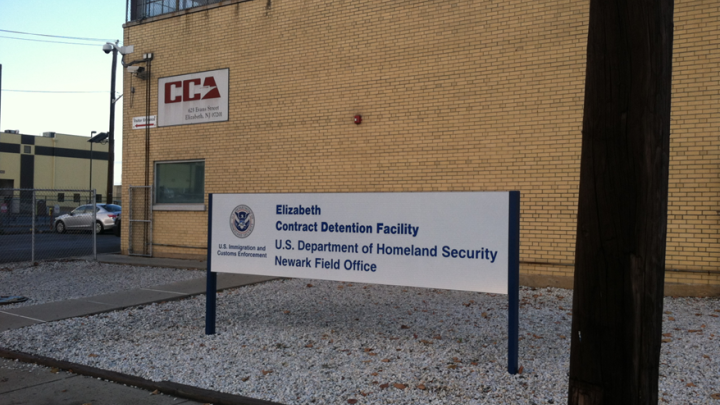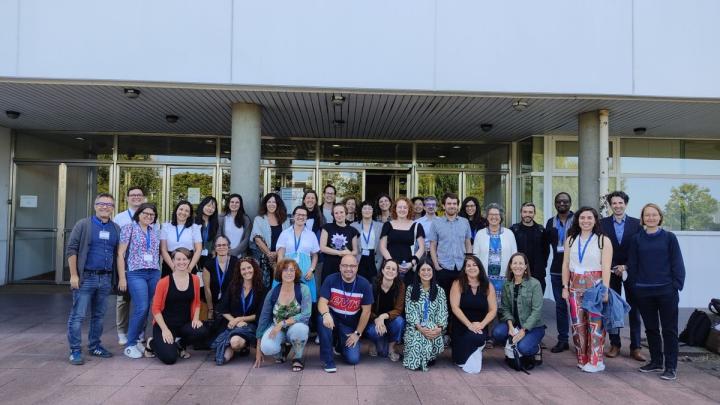Back to Business as Usual: The Impact of the COVID-19 Pandemic on Immigration Detention in Canada
Posted
Time to read
Guest post by Efrat Arbel and Molly Joeck. Efrat is Associate Professor at the University of British Columbia Peter A. Allard School of Law. Molly is a lawyer at Edelmann & Co. Law Offices, and PhD Candidate at the University of British Columbia Peter A. Allard School of Law. Both authors live and work on the traditional, ancestral, and unceded territory of the Coast Salish peoples, Sḵwx̱wú7mesh (Squamish), Stó:lō and Səlílwətaʔ/Selilwitulh (Tsleil-Waututh) and xʷməθkʷəyəm (Musqueam) Nations. This is the eleventh post of Border Criminologies’ themed series on 'The Changing Landscapes of Immigration Detention' organised by Ana Ballesteros-Pena and Cristina Fernández-Bessa.

The pandemic is a portal, Arundhati Roy wrote in April 2020. And at the time, so it seemed. Streets were empty, planes were grounded, lives turned upside down – and millions of people were dying. News outlets reported that incarcerated individuals were being released around the world in unprecedented numbers for fear that COVID-19 would tear its way through prisons – which it did. In the spring of 2020, it seemed as if immigration detention in Canada was part of this trend. COVID-19 swept through the institutions where immigration detainees are held – both provincial correctional facilities and dedicated immigration detention centres.
Preliminary research we conducted at that time demonstrated that the Immigration Division – the administrative tribunal responsible for detention decision-making in Canada – was routinely relying upon the risk posed to detainees by the pandemic as a justification for release. This constituted an unprecedented approach by the tribunal, which had previously treated conditions of detention as outside of its jurisdiction. Further, objective data demonstrated that the number of immigration detainees in provincial correctional facilities and dedicated immigration holding centres was at an unprecedented low.
2.5 years later, we have conducted further research, and the data we have obtained complicates our original impressions. This further research is multipronged. First, we conducted a series of 25 interviews in the summer of 2021 with lawyers, advocates, NGO workers, and designated representatives whose work engages immigration detention. We also examined statistics published annually by the Canada Border Services Agency on the number of noncitizens who are immigration detained in Canada. Finally, we looked at the evolution of the relevant case law.
The information we gathered, and the conclusions we have been able to draw, relate to the conditions of confinement during the pandemic, the impact of COVID-19 on procedures around the adjudication of detention (principally, the ramifications of the transition to remote hearings), and the ways in which the pandemic affected the legal reasoning of administrative decision-makers.
Our conclusions will be set out in detail in a forthcoming article. However, we would like to highlight our most significant findings here.
The particularized impact of COVID-19 on immigration detainees was acute, severe, and far reaching in its ramifications. Immigration detainees faced extreme isolation from their communities, and from each other. Even though all individuals in carceral facilities faced isolation, the impact on immigration detainees was particularized, as their chances of obtaining release are often contingent upon their ability to connect with people outside the carceral facility and obtain evidence corroborating their identity, rehabilitation, or ties with a community.
Another significant change was the shift from in-person detention hearings to virtual hearings. Under Canadian law, immigration detention is not subject to time limits – but it is subject to mandatory periodic review. Immigration detainees must appear before the Immigration Division initially after their detention, and every 30 days while their detention continues. These hearings are critical for the determination of release, and during the pandemic, all hearings were transitioned to video or teleconference. Our interview subjects provided very mixed feedback about this shift. On the positive side, interview subjects spoke of virtual hearings as increasing access to justice, insofar as it proved logistically easier for lawyers to represent detainees remotely, which meant that more detainees were able to access legal representation. Further, various interview subjects highlighted the gruelling nature of in-person hearings for detainees, given that transport to and from hearing sites has involved detainees being shackled and detained in tiny cells with many other detainees awaiting a hearing, all under gruelling conditions of confinement. Video or teleconference hearings meant that detainees could appear for their hearings from inside the facility in which they were held, which was challenging for some, but positive for others.
On the other hand, interview subjects spoke almost universally of the isolation wrought by virtual hearings on detainees. Virtual hearings have rendered it more difficult for lawyers and advocates to build trust in order to effectively represent detainees, especially those who are not fluent in English. Further, the virtual hearing, while increasing the number of detainees that can be represented, restricts the ambit of the representation – relying on the carceral facility and detaining authority to facilitate contact, inherently setting the terms of that contact, both conceptually and temporally. Interview subjects spoke of the challenges faced by detainees in understanding the hearing process, in meaningfully participating in the process, and in understanding the broader ramifications of the process.
Moreover, because immigration detainees in Canada are detained in provincial correctional facilities, they were effectively forced to compete with criminal detainees for the limited number of videoconferencing stations in such facilities. Decisions were being made about prioritizing certain hearings over others – and criminal bail hearings would inevitably take precedence over immigration detention review hearings – which meant that the latter were too often postponed. Finally, dropped calls and poor internet connections interfered with the hearing process, further alienating detainees and impeding access.
In sum, where the pandemic increased access to legal representation – meaning more detainees were represented in the course of their detention review hearings – all detainees were more isolated throughout the hearing process and had less meaningful contact with their lawyers.
As a result, since the onset of COVID-19, we have witnessed detainees being consistently alienated within the architecture of the Canadian immigration detention regime. Any improved access to legal representation has come at the cost of further erasing the humanity of detainees by isolating them from meaningful contact with advocates, lawyers, adjudicators, and other relevant actors.
As for what appeared to be increased release rates, the data proved that the contrary was in fact the case. Though most (but not all) of our interview subjects shared the impression that detainees were being released at higher rates than pre-pandemic, data published by the Canada Border Services Agency (CBSA) in 2022 on the number of detentions that occurred in 2020-2021 told a very dark story. The data shows that, while the overall number of people detained did decrease, the percentage of people detained relative to the number of entries by noncitizens to Canada increased. In 2020-2021, CBSA detained a higher percentage of non-citizens who entered Canada than at any point since 2012. More specifically, over the course of that year, Canada detained 0.054% of non-citizens who entered Canada, or 1,605 people. In the year before the pandemic (2019-2020), the percentage was 0.027. The highest percentage prior to that point was recorded in 2012-2013, as 0.031%. While the 2019-2020 numbers may capture a brief drop in detention in the second half of March 2020, the 2020-2021 fiscal year, when Canada was in the grips of the worst part of the pandemic, does not show a noticeable drop overall. This tells us that the liberatory possibilities of the pandemic that we and others were so keen to celebrate was not realized to the extent hoped. On the contrary, migrants were detained at a higher rate than they had been before, at a time when detention centres posed a very clear risk to the lives of all detainees.
That being said, our research was not without a glimmer of hope. As discussed in our 2020 piece, the shift in the Immigration Division’s approach to its jurisdiction over conditions of detention was eventually confirmed by Brown, a decision of the Federal Court of Appeal published in August 2020. Our review of the case law indicates that there have been some decisions that take the guidance of the Federal Court of Appeal in Brown seriously.
We were able to locate two decisions of the Immigration Division published since Brown where conditions of detention were a central concern. Both were rendered at the end of 2021/early 2022. Importantly, the pandemic was not at issue in either decision. Rather, in both cases, conditions of detention were discussed in relation to their effect on the mental health of the detainees. Both detainees suffered from serious mental illnesses, and both had experienced a significant decline in mental health as a result of time spent in detention. In both cases, the detainee’s lawyer made arguments about the impact of the conditions of detention on the detainee. In one case, the ID ordered released on that basis, finding that the detainee’s rights had been breached as a result of conditions of detention. Ultimately, the Federal Court overturned that decision, effectively sidestepping the issue of conditions of detention. The other was the opposite – the ID had ordered the detainee’s continued detention, largely ignoring the conditions of detention, and the Federal Court overturned that decision, in part because of the ID’s failure to take into consideration conditions of detention. In the latter case, the Federal Court declined to consider whether the detainee’s rights had been breached as a result of the conditions of detention.
This is indicative of a push by lawyers in the field to make arguments relating to conditions of detention. While the Federal Court seems reluctant to take the issue on, the body of case law will inevitably grow as arguments continue to be made, fostering the ability of detainees to make meaningful arguments about location and conditions of detention beyond the COVID-19 pandemic. Ultimately, this body of law may contribute to growing recognition of the harms of detention, and hopefully a shift towards less, and less harmful, detention.
Any comments about this post? Get in touch with us! Send us an email, or post a comment here or on Facebook. You can also tweet us.
How to cite this blog post (Harvard style):
E. Arbel and M. Joeck. (2023) Back to Business as Usual: The Impact of the COVID-19 Pandemic on Immigration Detention in Canada. Available at:https://blogs.law.ox.ac.uk/border-criminologies-blog/blog-post/2023/03/back-business-usual-impact-covid-19-pandemic. Accessed on: 07/04/2025YOU MAY ALSO BE INTERESTED IN
With the support of













